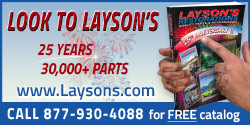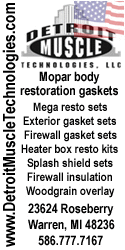TheGreatBoo
New Member
Hope I put this in the right place, its my first post so excuse me if I get this wrong. Also keep in mind that I am not a native English speaker so sometimes the words may come out a little funny, you'll just have to guess what I mean in those cases.
Thing is, me and my brother inherited a Satellite 65 after our dad passed away three years ago. We decided to fix it up together as a sort of remembrance thing. It has been standing in a barn for some 25 years and it lacks a carb since dad sent it to someone for tuning and they had since fallen out (some 20 yrs ago). Also, the barn is located 1100 km from where me and my brother live and when last the car was working I think I was 12 and my brother was 10 so or memories are somewhat sketchy, it will be a difficult undertaking...
Year -2: We started the year before last. According to the official Swedish records the Satellite's got an engine rated at 169kw, which made me assume its a 318 smallblock engine. I got a new Edelbrock 1405 carb for it (which a hoped would fit) and a throttle kit since I knew it too was missing. And away we went to get the car going.
After the long journey, 12 hours by car, we got to the old homestead where the car is. We hooked up the carb, which actually did fit, and put a new battery in. I expected a kick down wire somewhere from the gearbox but did not find any... No matter, we turned the key. It cranked, but no ignition. After trying some more there was a distinct smell of gas in the barn we heard a dripping sound... I did a check under the car and all the gas hose was rotted and leaking. We went into town and got some new fuel hose and put it in. After putting the new hose in we cranked the car again, it did not start this time either. I knew it got gas since I could now see it flowing through the fuel filter, so I assumed that the spark was missing. I checked, and no spark on any cylinder or on the main lead to the distributer. Crap. There was some "new" (1987 style new) ignition box in there and the ballast resistor and coil did not look to good. We decided to give it a rest, order new parts and come back next year.
Year -1: I order a new orange ignition box, a new coil and a new ballast resistor (please remember that I am a total noob and this is the first car I have done anything other than change the oil and filter on...) and last summer we once again headed north to work on the car armed with the new equipment. Changing out the ignition box and ballast resistor was easy, they fit right in (i roughed up the bottom of the ignition box and the plate where I mounted it to get a solid ground). We decided to wait on the ignition coil since it looked reasonably OK. Now to the big moment, we turn the key and: ... suspense... nothing! Some strange sounds but the engine does not turn over! It is 100% seized. What to do? We managed to acquire some 6in1 oil locally, it is a thin oil that is supposed to creep everywhere and loosen things up. I removed the spark plugs and filled the cylinder with as much as I could (mind you, removing the spark plugs on this car is not an easy job there is almost no room on the passenger side. Someone should have talked to those mopar engineers about serviceability back in the day...) Well, I get the oil in there and we let it simmer for a few days and try again, still stuck. We get a 31mm shell and a long handle and try to turn the engine by the main bolt. No luck... My guess is that all that 1987 style water laden gas that we were so happy seeing flowing into the engine last year made it totally seize up during the winter Well, lets hope for better luck next year... Before leaving for home we filled the engine with diesel by pouring it into the carb and opening the inlet valves with a large poly grip pliers.
Well, lets hope for better luck next year... Before leaving for home we filled the engine with diesel by pouring it into the carb and opening the inlet valves with a large poly grip pliers.
Year 0, present day: This year we went up north and hoped that the diesel and 6in1 oils would have worked their magic and that the engine would now freely turn over. Obviously that was not the case. The engine is still stuck. This annoyed me so bad. I freed up a large table for parts, got some post-it notes, a pen, (the post its and pen were so that I, in all my ignorance, could mark each item i took out of the engine to be able to put it all back together later) wd-40 and 5-56 oil and got all my tools out. I was determined to beat this engine.
I remover the Carb. I removed the manifold. I removed the driver side cam covers, cam shaft and exhaust. Ok nice, the driver side head is ready to be removed. And this is when it starts getting a little strange, there are three rows of head bolts... 4 top, 5 long middle, and something like 8 bottom bolts. This may not be a 318 smallblock after-all... No matter I push on. I remove the driver side head, I have no idea how to properly do this but I do it in a sort of from the sides to the middle star like manner (since that is the inverse of how I would have tightened them). Lets just hope I did not induce any twist in the head... So one head gone, about two tablespoons of rust flakes in all cylinder except the one at TDC. And all of them stuck. OK. Moving on to the passenger side. I can not remove the freaking exhaust. I manage to get "all" nuts off without breaking any bolts (it seems someone have already broken a couple of bolts off already, but doing something about that is currently beyond me) but the exhaust is still not possible to remove. Another 5mm and I could have slid it off the bolts but no. Who designed this car so it can not be worked on? What to do? I tried having my brother shift the engine with a crow bar, it was a futile attempt. In a final act of desperation I unbolt the passenger side engine mount from below and push the engine up on that side with a garage jack. Who would have known... It worked! So after finally removing the exhaust on the passenger side I remove that head as well. Same thing there dry cylinders with a couple of tablespoons of rust in each. SO. I add 6in1 oil to all cylinders and scrape down along the side of the cylinder into the first piston ring with a 0.1mm feeler gauge to remove rust. Then I reasonably "gently" tap all pistons top and bottom to get them to "wiggle" around the piston pin (or whatever it is called in English). This gets all pistons except one "free", at least feeling like they wiggle slightly when tapped. The last one is the one furthest back on the driver side. It is also the one with the least play between piston and cylinder. On all the other ones I was able to get the 0.1mm feeler gauge in between the cylinder and piston, but not this one. What to do?
At this point in time I am still not aware of the fact that the engine is probably not a 318 as the papers indicate but something else. There are little things, like the 3 row head bolts and the fact that the distributor is on the front of the engine that afterwards makes me believe this could be a bigblock... I did however (for no apparent reason just then) do a course measurement of one cylinder. Since one cylinder appeared to be at TDC I hoped the one furthest down would be bottomed out. If that is the case, the bore is ~105mm and the stroke ~86mm. This (I have later read) is actually very close to a 361 engine.
Not knowing how to proceed I oil everything up and also put a liberal amount of standard engine oil in all cylinders (and on all nuts and bolts) before bolting it all together (lightly). Next year the cylinders will NOT be dry and rusty. Also I fear I will have to get at least one new piston since the gentle tapping on the cylinder who would not move actually went pretty far beyond gentle at the end...
So, if anyone have managed to read through this enormously long first post of mine without falling asleep, any ideas on how I should proceed next year? I was going to buy "How to Rebuild the Small-Block Mopar" by William Burt, or "How to Rebuild Small-Block Mopar Engines" by Don Taylor. That seems kind of useless if its a bigblock 361 I am dealing with :eusa_think: Also, how do I actually determine which engine I got, is there some number on the block or something like that?
Best regards!
Thing is, me and my brother inherited a Satellite 65 after our dad passed away three years ago. We decided to fix it up together as a sort of remembrance thing. It has been standing in a barn for some 25 years and it lacks a carb since dad sent it to someone for tuning and they had since fallen out (some 20 yrs ago). Also, the barn is located 1100 km from where me and my brother live and when last the car was working I think I was 12 and my brother was 10 so or memories are somewhat sketchy, it will be a difficult undertaking...
Year -2: We started the year before last. According to the official Swedish records the Satellite's got an engine rated at 169kw, which made me assume its a 318 smallblock engine. I got a new Edelbrock 1405 carb for it (which a hoped would fit) and a throttle kit since I knew it too was missing. And away we went to get the car going.
After the long journey, 12 hours by car, we got to the old homestead where the car is. We hooked up the carb, which actually did fit, and put a new battery in. I expected a kick down wire somewhere from the gearbox but did not find any... No matter, we turned the key. It cranked, but no ignition. After trying some more there was a distinct smell of gas in the barn we heard a dripping sound... I did a check under the car and all the gas hose was rotted and leaking. We went into town and got some new fuel hose and put it in. After putting the new hose in we cranked the car again, it did not start this time either. I knew it got gas since I could now see it flowing through the fuel filter, so I assumed that the spark was missing. I checked, and no spark on any cylinder or on the main lead to the distributer. Crap. There was some "new" (1987 style new) ignition box in there and the ballast resistor and coil did not look to good. We decided to give it a rest, order new parts and come back next year.
Year -1: I order a new orange ignition box, a new coil and a new ballast resistor (please remember that I am a total noob and this is the first car I have done anything other than change the oil and filter on...) and last summer we once again headed north to work on the car armed with the new equipment. Changing out the ignition box and ballast resistor was easy, they fit right in (i roughed up the bottom of the ignition box and the plate where I mounted it to get a solid ground). We decided to wait on the ignition coil since it looked reasonably OK. Now to the big moment, we turn the key and: ... suspense... nothing! Some strange sounds but the engine does not turn over! It is 100% seized. What to do? We managed to acquire some 6in1 oil locally, it is a thin oil that is supposed to creep everywhere and loosen things up. I removed the spark plugs and filled the cylinder with as much as I could (mind you, removing the spark plugs on this car is not an easy job there is almost no room on the passenger side. Someone should have talked to those mopar engineers about serviceability back in the day...) Well, I get the oil in there and we let it simmer for a few days and try again, still stuck. We get a 31mm shell and a long handle and try to turn the engine by the main bolt. No luck... My guess is that all that 1987 style water laden gas that we were so happy seeing flowing into the engine last year made it totally seize up during the winter
Year 0, present day: This year we went up north and hoped that the diesel and 6in1 oils would have worked their magic and that the engine would now freely turn over. Obviously that was not the case. The engine is still stuck. This annoyed me so bad. I freed up a large table for parts, got some post-it notes, a pen, (the post its and pen were so that I, in all my ignorance, could mark each item i took out of the engine to be able to put it all back together later) wd-40 and 5-56 oil and got all my tools out. I was determined to beat this engine.
I remover the Carb. I removed the manifold. I removed the driver side cam covers, cam shaft and exhaust. Ok nice, the driver side head is ready to be removed. And this is when it starts getting a little strange, there are three rows of head bolts... 4 top, 5 long middle, and something like 8 bottom bolts. This may not be a 318 smallblock after-all... No matter I push on. I remove the driver side head, I have no idea how to properly do this but I do it in a sort of from the sides to the middle star like manner (since that is the inverse of how I would have tightened them). Lets just hope I did not induce any twist in the head... So one head gone, about two tablespoons of rust flakes in all cylinder except the one at TDC. And all of them stuck. OK. Moving on to the passenger side. I can not remove the freaking exhaust. I manage to get "all" nuts off without breaking any bolts (it seems someone have already broken a couple of bolts off already, but doing something about that is currently beyond me) but the exhaust is still not possible to remove. Another 5mm and I could have slid it off the bolts but no. Who designed this car so it can not be worked on? What to do? I tried having my brother shift the engine with a crow bar, it was a futile attempt. In a final act of desperation I unbolt the passenger side engine mount from below and push the engine up on that side with a garage jack. Who would have known... It worked! So after finally removing the exhaust on the passenger side I remove that head as well. Same thing there dry cylinders with a couple of tablespoons of rust in each. SO. I add 6in1 oil to all cylinders and scrape down along the side of the cylinder into the first piston ring with a 0.1mm feeler gauge to remove rust. Then I reasonably "gently" tap all pistons top and bottom to get them to "wiggle" around the piston pin (or whatever it is called in English). This gets all pistons except one "free", at least feeling like they wiggle slightly when tapped. The last one is the one furthest back on the driver side. It is also the one with the least play between piston and cylinder. On all the other ones I was able to get the 0.1mm feeler gauge in between the cylinder and piston, but not this one. What to do?
At this point in time I am still not aware of the fact that the engine is probably not a 318 as the papers indicate but something else. There are little things, like the 3 row head bolts and the fact that the distributor is on the front of the engine that afterwards makes me believe this could be a bigblock... I did however (for no apparent reason just then) do a course measurement of one cylinder. Since one cylinder appeared to be at TDC I hoped the one furthest down would be bottomed out. If that is the case, the bore is ~105mm and the stroke ~86mm. This (I have later read) is actually very close to a 361 engine.
Not knowing how to proceed I oil everything up and also put a liberal amount of standard engine oil in all cylinders (and on all nuts and bolts) before bolting it all together (lightly). Next year the cylinders will NOT be dry and rusty. Also I fear I will have to get at least one new piston since the gentle tapping on the cylinder who would not move actually went pretty far beyond gentle at the end...
So, if anyone have managed to read through this enormously long first post of mine without falling asleep, any ideas on how I should proceed next year? I was going to buy "How to Rebuild the Small-Block Mopar" by William Burt, or "How to Rebuild Small-Block Mopar Engines" by Don Taylor. That seems kind of useless if its a bigblock 361 I am dealing with :eusa_think: Also, how do I actually determine which engine I got, is there some number on the block or something like that?
Best regards!
















